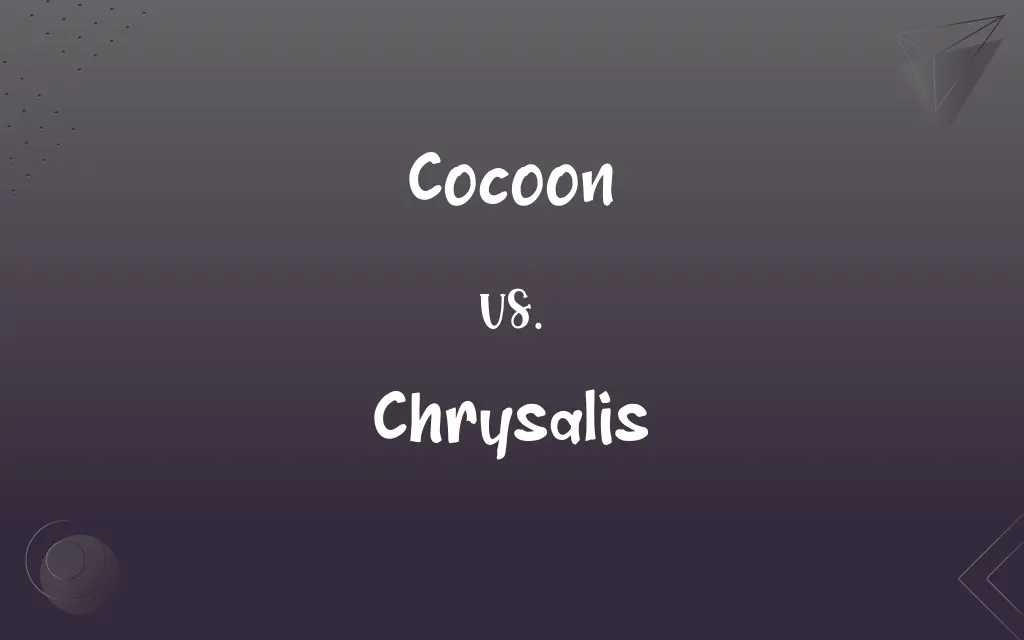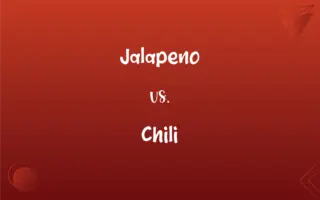Cocoon vs. Chrysalis: What's the Difference?
Edited by Aimie Carlson || By Janet White || Published on February 18, 2024
A cocoon is a protective casing spun by moths and other insects; a chrysalis is a hard protective covering formed by butterflies.

Key Differences
A cocoon, typically made by moths, is a silky covering that encases the pupa for protection during metamorphosis. In contrast, a chrysalis, associated with butterflies, is a hard outer shell formed from the caterpillar's skin, providing a secure environment for the pupating butterfly.
The cocoon is often woven from silk, creating a soft yet strong barrier against predators and environmental factors. The chrysalis, on the other hand, is not a spun structure but a transformation of the caterpillar's last skin layer, becoming a rigid protective case.
Cocoons can sometimes incorporate materials from the environment, like leaves or twigs, for added camouflage and protection. Chrysalises are generally more uniform in appearance, relying on color and shape for camouflage rather than additional materials.
The process of cocoon formation involves the insect spinning the cocoon around itself, a task that can take days. The formation of a chrysalis, however, is a quicker transformation, where the outer skin hardens into the protective casing.
Cocoons are commonly associated with a wider variety of insects, including moths and other non-butterfly species. Chrysalises are specific to butterflies, marking a distinct difference in the metamorphosis process between these closely related insects.
ADVERTISEMENT
Comparison Chart
Creator Species
Moths and other insects
Butterflies
Material Composition
Silky, often incorporating environmental elements
Hardened exoskeleton of the caterpillar
Protective Strategy
Spun structure, camouflaged with surroundings
Rigid case, camouflaged through color and shape
Formation Process
Spinning by the insect, taking several days
Transformation of the skin, a quicker process
Associated Diversity
Found in a variety of insects
Exclusive to butterflies
ADVERTISEMENT
Cocoon and Chrysalis Definitions
Cocoon
A cocoon is a silky covering spun by some insects during pupation.
The caterpillar spun a cocoon and transformed into a moth.
Chrysalis
In a broader sense, chrysalis can refer to anything in a transitional or formative state.
The company was in a chrysalis, evolving into something greater.
Cocoon
In a figurative sense, a cocoon represents a state of being isolated or insulated from the outside world.
He lived in a cocoon of ignorance, unaware of the realities outside.
Chrysalis
A chrysalis is the pupal stage of butterflies, where transformation occurs within a hardened case.
The chrysalis hung delicately from the branch, a butterfly soon to emerge.
Cocoon
Cocoon can refer to anything that envelops or protects something in a similar way.
She wrapped herself in a blanket, creating a cocoon of warmth.
Chrysalis
In literature, chrysalis often represents a period of significant change or transformation.
Her journey was a chrysalis, leading to a profound personal transformation.
Cocoon
In technology, cocoon refers to a framework or system that encases or integrates various components.
The software cocooned all the complex processes, making the user experience seamless.
Chrysalis
Chrysalis can symbolize a state of development or potential.
The young artist was in her chrysalis phase, her talent not yet fully realized.
Cocoon
Cocoon can be used as a verb, meaning to envelop or encase protectively.
The child cocooned the injured bird in her hands, trying to keep it safe.
Chrysalis
Chrysalis can be used metaphorically to describe a protective or nurturing environment.
The school acted as a chrysalis, fostering the students' growth.
Cocoon
A protective case of silk or similar fibrous material spun by the larvae of moths and certain other insects as a cover for the pupa.
Chrysalis
A pupa, especially of a butterfly.
Cocoon
A similar natural protective covering or structure, such as the egg case of a spider.
Chrysalis
The hardened case of a pupa.
Chrysalis
A protected stage of development.
Chrysalis
The pupa of a butterfly or moth, enclosed inside a cocoon, in which metamorphosis takes place.
Chrysalis
The cocoon itself.
Chrysalis
(figurative) A limiting environment or situation.
Chrysalis
To form a chrysalis.
Chrysalis
To metamorphize; to transform.
Chrysalis
The pupa state of certain insects, esp. of butterflies, from which the perfect insect emerges. See Pupa, and Aurelia (a).
Chrysalis
Pupa of a moth or butterfly enclosed in a cocoon
FAQs
What is a cocoon?
A protective case spun by some insects during metamorphosis.
Can a chrysalis be found on the ground?
Rarely, as they are typically attached to leaves or branches.
What is a chrysalis?
The pupal stage of butterflies, encased in a hard shell.
Are all chrysalises the same color?
No, their color can vary depending on the species.
Can cocoons be different shapes?
Yes, their shape can vary depending on the species.
Can a damaged chrysalis still hatch?
It depends on the extent of the damage, but often it is fatal.
Do cocoons serve as protection?
Yes, they protect the pupa from predators and environmental factors.
How long does an insect stay in a cocoon?
It varies, but it can range from a few weeks to months.
What happens inside a cocoon?
The insect undergoes metamorphosis, changing into its adult form.
Which insects create cocoons?
Mainly moths and some other insect species.
Is a chrysalis alive?
Yes, it is a living stage in the butterfly's life cycle.
Do chrysalises move?
They can twitch if disturbed, but generally, they do not move.
What's the texture of a cocoon like?
Generally silky and sometimes padded with other materials.
Is a chrysalis the same as a cocoon?
No, they are different; a chrysalis is specific to butterflies.
How do butterflies emerge from a chrysalis?
They secrete enzymes to soften the case and then struggle out.
Can you see the butterfly inside a chrysalis?
Sometimes, especially when the chrysalis is nearing the end of its phase.
What's the purpose of a cocoon's camouflage?
To hide it from predators and blend in with the environment.
How long does a butterfly stay in a chrysalis?
Usually a few weeks, but it varies with species and conditions.
How do insects breathe in a cocoon?
They breathe through tiny holes called spiracles that allow air exchange.
Are cocoons reused by insects?
No, they are typically used only once.
About Author
Written by
Janet WhiteJanet White has been an esteemed writer and blogger for Difference Wiki. Holding a Master's degree in Science and Medical Journalism from the prestigious Boston University, she has consistently demonstrated her expertise and passion for her field. When she's not immersed in her work, Janet relishes her time exercising, delving into a good book, and cherishing moments with friends and family.
Edited by
Aimie CarlsonAimie Carlson, holding a master's degree in English literature, is a fervent English language enthusiast. She lends her writing talents to Difference Wiki, a prominent website that specializes in comparisons, offering readers insightful analyses that both captivate and inform.







































































